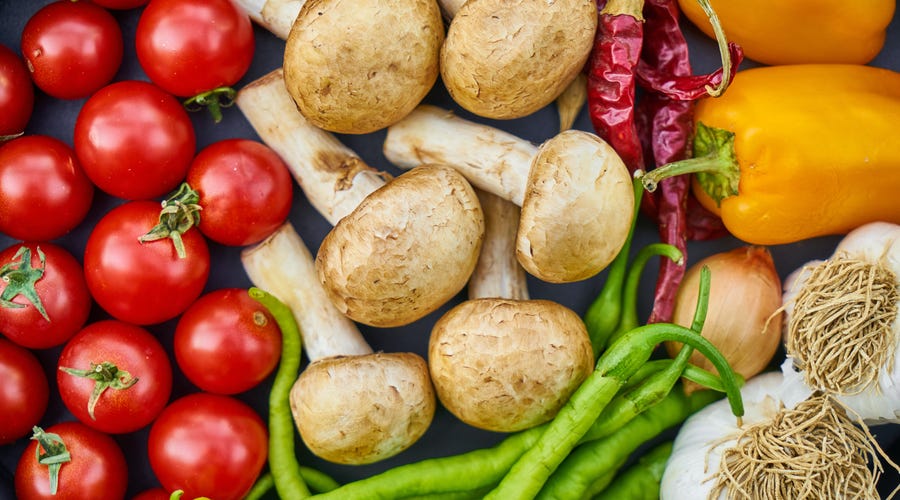
109 vegetable names in English you'll want to feast on
Author: Karolina Assi
There are many different vegetables in English, and learning about them can open your world up to new flavors, cultures, and cuisines.
Whether you eat at home or in a restaurant, learning to name different vegetables in any language is a must, and English is no different.
It's useful at the grocery store, at home, and when ordering food on the phone. The more vegetables you know in English, the higher your chances of being able to correctly identify them when they're mentioned in the conversation!
There's a big world of vegetables out there, and while you may not enjoy eating all of them, they're important from a culinary standpoint because many are used in cuisines around the world.
The English language has a wide vocabulary of vegetables, and you probably don’t know them all - even if you’re a native speaker! This is why we’ve compiled this list of 109 vegetables in English. We’ve divided them by specific categories so you can easily browse through the list and find what you’re looking for.
Why learn to name vegetables in English?
It's easy to take veggies for granted, but learning the names of these common foods is extremely useful. Here are a few reasons why.
You’ll be able to order exactly what you want
If you’re ordering at a restaurant and want an eggplant, it won’t do you any good to say, “I want that big purple thing!” Not only will the waiter look at you funny, but they may bring back something completely different from what you had in mind.
If you know the names of different vegetables, you can speak more confidently when ordering - and you won’t have any surprises when your food arrives!
You’ll be able to understand cooking shows
Many people like to watch cooking shows on TV, but if you don’t know the names of some common ingredients in English, it can be tricky - or even impossible - to follow along.
When the chef says “chop up an onion” or “add diced tomatoes to the pan,” will you know what they mean? Learning these words will help!
You’ll be able to understand recipes on the internet
You can find all kinds of recipes online, which is wonderful! However, if you don't know the names of vegetables in English, you might get confused and cook the recipes with a completely different ingredient!
Learning how to name a diverse range of veggies will allow you to fully understand the recipes and buy the right ingredients at the supermarket.

List of vegetables in English
The English word “vegetable” (pronounced ˈvɛʤtəbəlz) has many origins. It’s thought to derive mainly from Latin words such as “vegetabilis,” meaning “growing, flourishing,” or “vegetare,” meaning “to enliven.” If you’re on good terms with vegetables, you can also lovingly call them “veggies.”
The most common way to group vegetables is by the part of the plant that is edible, such as roots, tubers, bulbs, flowers, or leaves. For example, a carrot is a root vegetable, while spinach is a leafy vegetable.
Let’s finally spill the beans and dive into our list of 109 types of vegetables and their pronunciation.
Root vegetables in English
You certainly consume many root vegetables in your diet, such as beetroots or carrots. Root vegetables are… well, edible roots of the plant. Plus, some spices that we eat in our diets, such as ginger or turmeric, are also considered stem vegetables.
Here’s the list of every possible root vegetable that we could find on the internet.
| English | IPA Pronunciation |
|---|---|
| Beetroot | /ˈbitrut/ |
| Carrot | /ˈkærət/ |
| Daikon (white radish) | /daikonwaɪtˈrædɪʃ/ |
| Celeriac | /səˈleriæk/ |
| Parsnip | /ˈpɑsnɪp/ |
| Radish | /ˈrædɪʃ/ |
| Salsify root | /ˈsælsɪfirut/ |
| Swede | /swid/ |
| Turnip | /ˈtɜnɪp/ |
| Rutabaga | /ˌrutəˈbeɪɡə/ |
| Jicama | /’hikama/ |
| Maca | /‘maka/ |
| Celery root | /ˈselərirut/ |
| Horse-radish | /ˈhɔsˌrædɪʃ/ |
| Galangal | /galangal/ |
| Lotus root | /ˈləʊtəsrut/ |
| Parley root | /ˈpɑlirut/ |
| Turmeric | /ˈtɜmərɪk/ |
| Ginger | /ˈdʒɪndʒə/ |

Bulb vegetables in English
Bulb vegetables have this name because they look like a bulb and consist of layers. We often use them to make delicious soups or to flavor a savory meal, such as onion, garlic, or leek. Here’s a list of the most common bulb vegetables in English.
| English | IPA Pronunciation |
|---|---|
| Onion | /ˈʌnjən/ |
| Spring onion | /sprɪŋˈʌnjən/ |
| Garlic | /ˈɡɑrlɪk/ |
| Leek | /ˈlik/ |
| Shallot | /ʃəˈlɑt/ |
| Fennel bulb | /ˈfenl̩ˈbəlb/ |
Stem and shoot vegetables in English
Stem vegetables can be essentially described as the edible trunk of a plant, such as asparagus. Here’s a list of some of the most popular stem vegetables.

| English | IPA Pronunciation |
|---|---|
| Asparagus | /əˈsperəɡəs/ |
| Bamboo shoots | /bæmˈbuˈʃuts/ |
| Celery stalks | /ˈseləriˈstɑks/ |
| Kohlrabi | /ˌkoʊlˈrɑbi/ |
| Pikopiko | /pikopiko/ |
Tuber vegetables in English
If you’ve landed on this category, you’re likely asking yourself what tuber vegetables are. Aren’t they the same as root vegetables? Not really. There’s a slight difference between them.
Root vegetables have a simple dynamic: the root part that we eat grows underground, and the leafy part grows above the ground. Tubers, on the other hand, have hairy roots underground, then the tuber part above the ground (that’s what we consume).
So now that we’ve got a better understanding of what tuber vegetables are, here’s a list of some of the most common ones.
| English | IPA Pronunciation |
|---|---|
| Potato | /pəˈteɪˌtoʊ/ |
| Sweet potato | /ˈswitpəˈteɪˌtoʊ/ |
| Yuca | /’juka/ |
| Cassava | /kəˈsɑvə/ |
| Earth gems | /ˈɜθˈdʒemz/ |
| Jerusalem artichoke | /dʒəˈrusələmˈɑtɪtʃoʊk/ |
| Kumara | /’kumara/ |
| Taro root | /ˈteroʊˈrut/ |
| Yam | /ˈjæm/ |
| Yautia | /‘jautia/ |
Flower vegetables in English
Flower vegetables are… well, edible flowers. These are pretty much all the vegetables our moms made us eat when we were little. Who remembers throwing tantrums whenever broccoli appeared on the dinner table?
Here’s a list of some flower vegetables worth knowing in English.
| English | IPA Pronunciation |
|---|---|
| Broccoli | /ˈbrɑkəli/ |
| Cauliflower | /ˈkɑləˌflɑwər/ |
| Broccoflower | /ˈbrɑkoflɑwər/ |
| Broccolini | /ˈbrɑkolini/ |
| Choi sum | /ˌtʃɔɪˈsəm/ |
| Courgette | /kʊəˈʒet/ |
| Gai lan | /ɡaiˈlæn/ |
Fungi and mushrooms in English
Fungi have been used as food for centuries; however, there is some debate about whether they should be considered “vegetables.” Technically speaking, mushrooms aren’t plants, but the fruit bodies of members of the kingdom Fungi, which includes molds, yeast, and mushrooms.
Although that doesn’t sound delicious at all, fungi are used in many cuisines around the world - particularly Japanese and Chinese - to create savory, exotic dishes.
Here’s a list of some of the most common fungi and mushrooms in English that you probably have never heard of.
| English | IPA Pronunciation |
|---|---|
| Mushrooms | /ˈmʌʃrumz/ |
| Black fungus | /blækˈfʌŋɡəs/ |
| Button | /ˈbʌtn̩/ |
| Cups | /ˈkəps/ |
| Enoki | /enoki/ |
| Oyster | /ˌɔɪstər/ |
| Portobello | /portobello/ |
| Shiitake | /ʃitake/ |
| White ear | /ˌwaɪtˈɪr/ |
| Truffles | /ˈtrʌfl̩z/ |
Leaf vegetables in English
Leaf vegetables are edible leaves of the plant, such as spinach or lettuce. In English, there’s a wide variety of leaf vegetables that you probably heard of. However, the names of some of the less known leaves, such as tung ho, come from Japan or China, where they are primarily consumed.
Here’s an extensive list of leaf vegetables.

| English | IPA Pronunciation |
|---|---|
| Bok choy | /ˈbɑkˌtʃɔɪ/ |
| Brussels sprouts | /ˈbrʌsl̩zˈspraʊts/ |
| Cabbage | /ˈkæbədʒ/ |
| Red cabbage | /ˈredˈkæbədʒ/ |
| Cavolo nero | /kavoloˈnɪroʊ/ |
| Kale | /ˈkeɪl/ |
| Arugula | /aru’gula/ |
| Spinach | /ˈspɪnətʃ/ |
| Lettuce | /ˈletəs/ |
| Flower sprouts | /flaʊərˈspraʊts/ |
| Ong choi | /ˈɒŋˌtʃɔɪ/ |
| Raddichio | /’raditʃɪɔ/ |
| Silverbeet | /’sɪlvərbit/ |
| Sorrel | /ˈsɔrəl/ |
| Taro leaves | /ˈteroʊˈlivz/ |
| Tat soi | /ˈtætsoi/ |
| Tung ho | /ˈtʌŋˈhoʊ/ |
| Watercress | /ˈwɒtərˌkres/ |
| Witloof | /’witluf/ |
| Yen choi | /ˈjenˌtʃɔɪ/ |
“Fruit” vegetables in English
Are you confused yet with all the different vegetable types? We’re about to confuse you even more! Some vegetables that you eat on a daily basis, such as cucumbers, bell peppers, or tomatoes, are technically not even vegetables.
They’re fruits pretending to be vegetables on your plate! But we’re about to uncover them. Here’s a list of some fruits disguised as vegetables.

| English | IPA Pronunciation |
|---|---|
| Bell pepper | /belˈpepər/ |
| Cucumber | /ˈkjukʌmbər/ |
| Tomato | /təˈmeɪˌtoʊ/ |
| Bitter melon | /ˌbɪtəˈmelən/ |
| Capsicum | /ˈkæpsɪkəm/ |
| Chilli peppers | /ˈtʃɪliˈpepərz/ |
| Choko | /ˈtʃoko/ |
| Courgette/zucchini | /kʊəˈʒet/zuˈkini/ |
| Eggplant/aubergine | /ˈegˌplænt/ˈoʊbəʒin/ |
| Fuzzy melon | /ˈfʌziˈmelən/ |
| Lauki | /lauki/ |
| Marrow | /ˈmeroʊ/ |
| Okra | /ˈoʊkrə/ |
| Plantain | /ˈplæntən/ |
| Squash/pumpkin | /ˈskwɒʃ/ˈpʌmpkən/ |
| Scallopini | /scallopini/ |
| Spaghetti squash | /spəˈɡetiˈskwɑʃ/ |
| Tindora | /tindora/ |
| Tomatillo | /tomatillo/ |
| Turia | /turia/ |
Seeds and legumes in English
There is a lot of confusion about what are legumes and seeds. Legumes are plants that have protective seed coats, while seeds are the tiny, hard-shelled fruits that come in various shapes and sizes.
Legumes include beans, peas, and lentils, while seeds include corn and soybeans. Here’s a list of different seeds and legumes in English.
| English | IPA Pronunciation |
|---|---|
| Beans | /ˈbinz/ |
| Peas | /ˈpiz/ |
| Sweetcorn | /ˈswitkɔrn/ |
| Lentils | /ˈlentl̩z/ |
| Chickpeas | /ˈtʃɪkpiz/ |
| Fava beans | /ˈfɑvəˈbinz/ |
| Soy nuts | /ˌsɔɪˈnəts/ |
| Broad beans | /brɔdˈbinz/ |
| Snow peas | /ˈsnoʊˈpiz/ |
| Sugarsnap | /ˈʃʊgərsnæp/ |
| Edamame | /edamame/ |
Common and useful vegetable idioms
Did you know that in English, there are many useful expressions with vegetables? Knowing these idioms will help you speak more fluently, convey your message in a more dynamic way, and impress your colleagues with your English skills!
Here are a few idioms with veggies in English with their meaning:
- To be full of beans = To be very energetic and enthusiastic
- To be as cool as a cucumber = To be very calm
- To dangle a carrot in front of someone = To tempt someone to do something
- To be like two peas in a pond = To be very similar
- To be in a pickle = To be in a difficult situation that you don’t know the solution to
- To be a couch potato = To be someone who doesn’t like to move a lot and spends all day watching TV on their couch
Enjoy your veggies!
On this list, you’ll find typical vegetables that appear in your daily diet. But, you’ll also find more exotic vegetable names that you’ve probably never heard of.
We hope that thanks to this list, you’ll be able to name your favorite veggies and use this vocabulary in practical situations!
If you’d like to learn more useful English vocabulary, check out our English language blog or sign up for English language classes with us!


